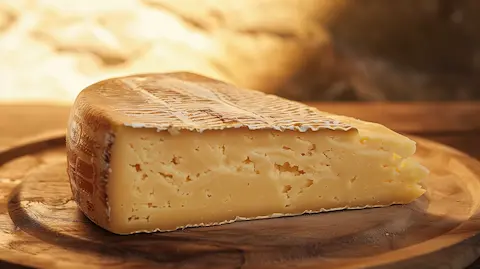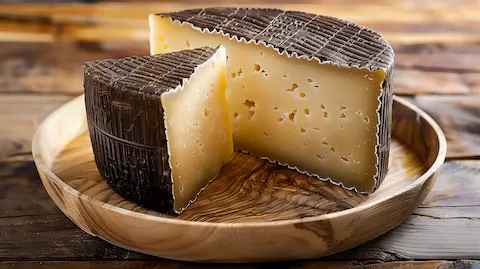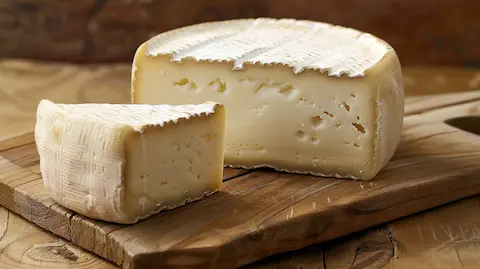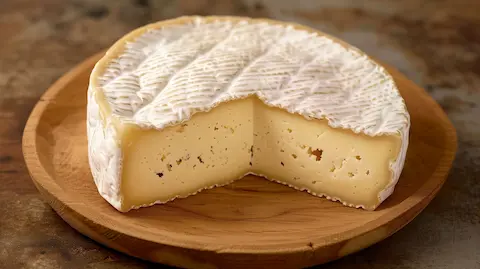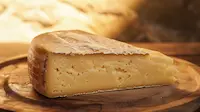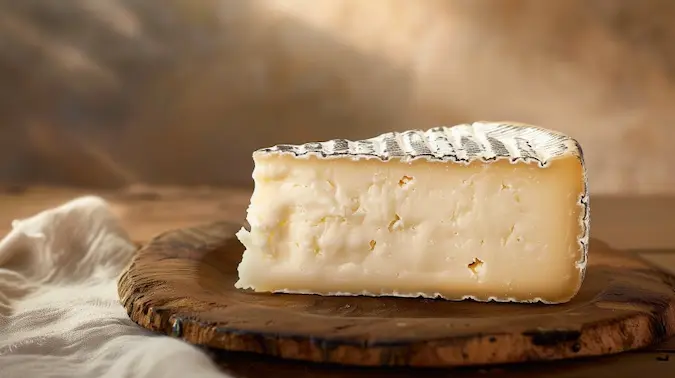Humboldt Fog Cheese
Humboldt Fog is a distinguished soft-ripened cheese crafted from goat milk, originating from the misty Humboldt County in California. Known for its central line of edible vegetable ash, this cheese unfolds a symphony of flavors: buttermilk and fresh cream harmonize with floral and herbaceous notes, culminating in a crisp citrus finish. As it ages, the flavors of Humboldt Fog deepen, offering a more intense cheese experience.
Let's explore how this award-winning cheese comes to life in the following section.
How is Humboldt Fog Made?
Humboldt Fog cheese is made using a meticulous process that combines traditional cheesemaking techniques with modern innovation. Here is an in-depth look at the production process:
| Ingredients | Methods |
|---|---|
| 1. Pasteurized cultured goat milk | 1. The goat milk is pasteurized to ensure safety and quality. |
| 2. Salt | 2. Salt is added to enhance flavor and aid in preservation. |
| 3. Enzymes | 3. Enzymes are introduced to facilitate the curdling process. |
| 4. Vegetable ash | 4. Vegetable ash is carefully applied to create the signature central line. |
| 5. The milk is inoculated with cultures to promote fermentation. | |
| 6. The milk is coagulated to form curds. | |
| 7. The curds are cut and gently stirred to release whey. | |
| 8. The curds are molded and drained to remove excess moisture. | |
| 9. The cheese is aged in a carefully controlled environment to develop its unique flavors and textures. |
This meticulous process ensures that Humboldt Fog cheese achieves its distinctive taste and appearance. Now, let's explore the flavor profile of this renowned cheese.
Humboldt Fog Cheese Profile
With its complex character and unique presentation, Humboldt Fog stands out in the world of cheese. Below is a comprehensive profile that encapsulates the essence of this delectable creation.
- Made from: Pasteurized cultured goat milk
- Country of origin: United States
- Region: Humboldt County, California
- Family: Soft-ripened
- Type: Goat cheese
- Texture: Creamy with a soft rind
- Rind: Bloomy
- Colour: White with a line of edible vegetable ash
- Flavour: Mild with complexity increasing as it matures
- Aroma: Fresh with hints of buttermilk and herbs
- Vegetarian: Yes, uses microbial rennet
- Producers: Cypress Grove
How to Store Humboldt Fog?
Proper storage of Humboldt Fog is vital to maintain its quality and extend its shelf life. This cheese thrives in a cool, humid environment, ideally within a refrigerator. To preserve its delicate flavor and texture, it should be wrapped in wax or parchment paper, then loosely in plastic wrap or placed in an airtight container. This method allows the cheese to breathe while retaining moisture.
- Step 1: Wrap - Encase Humboldt Fog in wax or parchment paper.
- Step 2: Cover - Loosely wrap the paper-covered cheese in plastic wrap or place it in an airtight container.
- Step 3: Refrigerate - Store the wrapped cheese in the refrigerator, ideally in a vegetable drawer where humidity is higher.
- Step 4: Monitor - Check the cheese periodically for any signs of spoilage and consume within the recommended timeframe.
How long does Humboldt Fog cheese last?
Humboldt Fog's longevity depends on how it's stored. When kept in the refrigerator, an uncut wheel can last up to its expiration date, while a cut piece should be consumed within a week for optimal quality. Freezing is not recommended, as it can alter the texture and taste, making the cheese crumbly and less flavorful upon thawing.
| Storage Location | Uncut Shelf Life | Cut Shelf Life |
|---|---|---|
| Outside | 2-4 hours | |
| Fridge | Up to expiration date | 1 week |
| Freezer | Not recommended | Not recommended |
Can You Freeze Humboldt Fog?
No, freezing Humboldt Fog cheese is not advised. Freezing can significantly alter its creamy texture, leading to a crumbly consistency, and may also diminish the nuanced flavors that are characteristic of this cheese. For the best experience, enjoy Humboldt Fog fresh and follow the recommended storage guidelines.
Alternatives to Humboldt Fog Cheese
For those seeking a similar cheese experience to Humboldt Fog, there are several alternatives that offer comparable textures and flavors. Whether you're looking for a similar goat cheese or a different milk base with a parallel profile, the following options provide delightful substitutes.
Substitutes for Humboldt Fog Cheese
| Cheese | Origin | Milk Source | Texture | Flavor | Why a Good Substitute? |
|---|---|---|---|---|---|
| Morbier | France | Cow | Semi-soft | Fruity and nutty | Features a similar aesthetic with an ash line through the center, and offers a creamy texture. |
| Valençay | France | Goat | Soft | Citrusy and salty | Another ash-coated goat cheese, with a tangy flavor profile and a pyramid shape. |
| Monte Enebro | Spain | Goat | Soft to semi-soft | Tangy and pungent | Spanish goat cheese with an intense flavor and a similar bloomy rind. |
| Bijou | United States | Goat | Soft | Sweet and yeasty | Small, crottin-style goat cheese that ages to develop complex flavors like Humboldt Fog. |
| Caprifeuille Saint-Maure | France | Goat | Soft | Earthy and tangy | Comes in a log shape with a similar texture and a line of vegetable ash under the rind. |
Next, we will explore the various ways to savor humboldt fog in your culinary creations.
How to Use Humboldt Fog
Enjoying Humboldt Fog in various dishes enhances meals with its creamy texture and dynamic flavor profile. When incorporating this cheese into recipes, it's best to cut it into thin slices or crumble it, depending on the desired presentation and texture. For slicing, use a wire cheese cutter or a sharp knife, and aim to cut through both the creamy and firmer parts of the cheese to ensure each piece has a bit of both textures.
- Salads: Crumble atop greens for a tangy touch.
- Charcuterie Boards: Serve as a centerpiece with fruits and nuts.
- Burgers: Melt over patties for a gourmet twist.
- Grilled Cheeses: Layer inside for a decadent sandwich.
- Fig Jam Pairing: Spread on a baguette with fig jam for a sweet and savory snack.
- Omelets: Incorporate into eggs for a breakfast upgrade.
- Pizza Topping: Dot over pizza before baking for a creamy addition.
Let's now move on to the culinary delights that await with Humboldt Fog in the kitchen.
Recipes Using Humboldt Fog
Humboldt Fog's creamy texture and complex flavor make it a versatile ingredient in many dishes. Its ability to melt beautifully lends itself to warm recipes, while its crumbly nature is perfect for cold dishes.
- Fig and Humboldt Fog Tart: The sweetness of figs complements the tangy notes of Humboldt Fog, creating a delightful balance in this elegant tart.
- Roasted Beet Salad with Humboldt Fog: The earthiness of beets paired with the creaminess of Humboldt Fog elevates this salad to a gourmet level.
- Prosciutto-Wrapped Chicken with Humboldt Fog Sauce: The saltiness of prosciutto and the rich sauce made from Humboldt Fog add depth to the succulent chicken.
- Humboldt Fog Macaroni and Cheese: A sophisticated twist on a classic, adding a luscious creaminess and a complex flavor profile to the dish.
- Peach and Humboldt Fog Grilled Cheese: The combination of sweet peaches and the melt-in-your-mouth cheese is a testament to the versatility of Humboldt Fog in sandwiches.
Now, let's examine the nutritional aspects of Humboldt Fog cheese.
Humboldt Fog Nutrition Data
There are 300 calories in Humboldt Fog cheese per 100g. This cheese is a source of protein and calcium, making it a nutritious addition to a balanced diet. Below is a detailed nutritional breakdown for those who wish to understand the specifics of its content.
| Nutrient | Amount per 100g | % Daily Value* |
|---|---|---|
| Calories | 300 | 15% |
| Total Fat | 25g | 38% |
| Saturated Fat | 16g | 80% |
| Cholesterol | 75mg | 25% |
| Sodium | 450mg | 19% |
| Total Carbohydrates | 3g | 1% |
| Protein | 20g | 40% |
| Calcium | 200mg | 20% |
| Potassium | 100mg | 3% |
* Percent Daily Values are based on a 2,000 calorie diet. Your daily values may be higher or lower depending on your calorie needs.
Next, we'll guide you through WhatCheese insights on the future of cheese enjoyment.
What's Next? WhatCheese Insights
As a passionate advocate for the art of cheese, I am constantly on the lookout for exceptional cheeses that resonate with the discerning palates of our community at WhatCheese. Fontina, with its rich history and exceptional versatility, is a cheese that deserves a spotlight. Originating from Italy's Aosta Valley, Fontina is a classic with a smooth, nutty flavor that melts into pure delight, making it perfect for fondue, quiches, and savory pastries. For those in pursuit of fontina, specialty cheese shops and high-end grocers often carry this delicacy. Moreover, many renowned vineyards offer cheese tastings that include Fontina, allowing enthusiasts to appreciate the cheese in a context that highlights its depth and compatibility with fine wines.
Participating in cheese events is a fantastic way to deepen your appreciation for Fontina and other artisanal cheeses. These gatherings are not only educational but also provide a platform to taste and compare a variety of cheeses in a convivial setting. Below is a table of re-occurring events where Fontina and other cheeses take center stage.
As we continue to explore the world of cheese together, I invite you to keep an eye on our platform for more insights, profiles, and delightful recipes that celebrate the rich diversity of cheese. If you're fond of the semi-hard texture and the savory richness of Fontina, you might also enjoy Gruyère, Gouda, or Emmental. These cheeses offer a similar firmness and are excellent in cooked dishes or simply enjoyed on their own.




